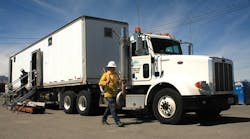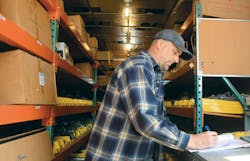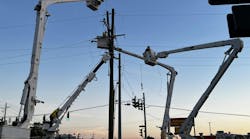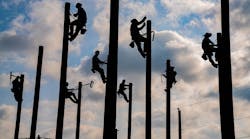NV Energy stocks its linemen’s vehicles with tools and hardware suitable for most repairs. When disaster strikes, however, the field workforce may be short-handed when it comes to the necessary materials needed to repair damaged infrastructure.
That’s where the “Rolling Warehouse” comes in. NV Energy invested in an emergency material trailer (EMT) to serve the utility’s northern Nevada service territory. That way, if the linemen can’t get to the warehouse, the company can bring the warehouse directly to them.
NV Energy packed the 45-ft-long semi-trailer with 281 different items that line crews may need when they’re repairing or rebuilding power lines destroyed by wildfires or violent storms. The trailer is stocked with about 60,000 lb of inventory valued at about $75,000, and it’s kept near the Reno, Nevada, warehouse loading dock.
NV Energy hauls the EMT behind a 500-hp Peterbilt diesel that’s powerful yet nimble enough to deliver the goods over sketchy roads in nasty weather.
The utility has been relying on the mobile warehouse since the first version was fabricated in the mid-1980s at the suggestion of warehouse employees. It has proved particularly useful during emergencies because the company’s northern Nevada service area is spread out over a wide geographic area covering more than 41,000 sq miles of mountainous, mostly rural territory. Compounding the challenge, the site of the emergency is often many miles from one of the company’s 10 warehouses, the largest of which is located at the operations center in Reno.
Transporting Materials for Overhead Lines
If you take a look inside the EMT, you’ll discover everything needed to repair or rebuild any overhead distribution line up to 60 kV. Among the items stacked on the shelves are insulators, crossarms, a variety of hardware, safety equipment, headlamps, rope and gloves. It is also equipped with a generator that keeps the trailer heated and lit, a two-way radio, a coffee maker, bottled water, energy drinks and snacks. The trailer is maintained and operated by the company’s supply chain materials department. When deployed, it’s usually staffed by one or two employees.
Depending on the season and the nature of the disaster, warehouse workers may customize the trailer’s inventory with snowshoes, fire extinguishers, face masks and shovels.
Before the advent of the EMT, the normal procedure was for a crew to load any extra materials anticipated for the job on their line truck, travel to the scene, assess the damage and then determine what other materials might be needed. Then they relayed that information to the warehouse. The appropriate hardware was then staged for pickup and delivery to the site by someone from the line crew or warehouse. Depending on the location of the damage, the evaluation and delivery process used to take up to 12 hours.
Saving Valuable Time for the Crews
If the EMT is dispatched to the site of the incident early on, precious time can be saved for crews in the field. That means NV Energy customers affected by the outage will have their service restored much more swiftly.
An excellent example of how the EMT benefits customers was the Washoe Drive wildfire that occurred in January 2012 in a residential area near Reno. Improperly discarded fireplace ashes ignited a blaze that rapidly burned through 3,000 acres, resulting in the evacuation of 10,000 residents. The fire destroyed 47 homes and outbuildings as well as 62 NV Energy electric distribution poles and four H-frame transmission structures.
Although many of the 2,800 affected customers were back in service quickly through circuit isolation and switching, more than 1,700 customers could not have their service restored until one of the burned radial circuits was completely rebuilt and reenergized.
The EMT was hauled to a safe location near the wildfire site, along with poles from the Reno warehouse and a vendor, providing the 10 crews on site with quick access to nearly everything needed to reconstruct the line. Once they were given permission to enter the fire zone, NV Energy line crews, working at night amid the smoke and ash, replaced 29 distribution poles. By 8 a.m. the next morning, power was restored to all but about 200 customers. And less than 20 hours after the start of the fire, all the customers who could accept service were back in power.
The EMT reduced outage time for customers affected by the fire by several hours, prompting company managers to describe the trailer as a logistics hero.
While the trailer doesn’t carry power poles, NV Energy has a unique relationship with a utility pole manufacturing company called Nevada Wood Preserving. The company has a production facility in northern Nevada, near the community of Silver Springs. They’re able to deliver poles from their large storage yard directly to work sites around northern Nevada and to off-load individual poles at the precise locations where they are needed. That’s another valuable time saver for crews trying to restore service to customers.
Answering the Call for More Than 25 years
Over the past 25-plus years, the company’s rolling warehouse has been deployed to about 30 emergencies throughout the region, everywhere from Lake Tahoe, Nevada, where the 2007 Angora fire destroyed nearly 250 homes, to the isolated Smoky Valley in central Nevada, where heavy snow and strong winds took down 50 poles during the 1980s.
The trailer’s inventory is frequently evaluated to ensure the supplies conform to the company’s material standards for overhead distribution lines and that the contents are up to date. For example, the heavy porcelain insulators that were kept aboard have been replaced with much lighter polymer insulators, and the trailer’s load has been lightened with polymer arresters and cutouts. NV Energy’s supply chain materials management team also upgraded the trailer’s electrical system and lighting in 2012.
Serving as an Operations Hub
It’s up to NV Energy’s area managers to decide whether to request use of the EMT. Generally, the trailer is deployed when the emergency is in a remote area, when it’s expected to substantially deplete inventories at the nearest warehouse, and when emergency power restoration involves significant material needs or multiple structures.
Company managers say the EMT often serves as a makeshift operations center for crews working to restore power after disasters. It’s a place where foremen can have tailgate meetings with other foremen to coordinate strategies for getting line repairs completed quickly and safely. And it’s also where linemen can take a quick break from the action and get rehydrated and recharged, and escape briefly from the cold during Nevada snowstorms.
Because there’s a two-way radio on board, crews are still able to keep track of their coworkers in the field. If they’re at the scene of a wildfire, they’ll be able to tune in to the emergency bands used by firefighters to keep posted on the latest developments.
According to the employees who manage the trailer, it is stocked with about 90% of everything a line crew might need to make repairs to the company’s electric distribution system. They say all it is lacking is a pizza oven. However, one thing is absolutely certain for this warehouse on wheels — it delivers.
Scott Jensen ([email protected]) is the manager of supply chain materials for NV Energy. He has been with the company for 34 years and is responsible for all aspects of supply chain materials management for generation, transmission and distribution throughout NV Energy’s northern Nevada service area.
Carolyn Barbash ([email protected]) is the executive of energy delivery for NV Energy. She has been with the company for the past 24 years, and manages electric distribution operations, maintenance, and design and construction throughout NV Energy’s northern Nevada service area.




